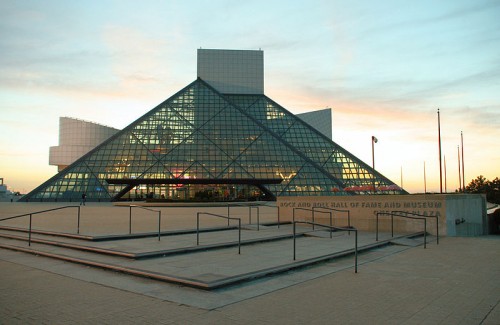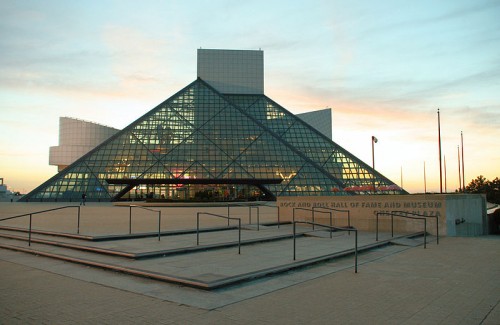
Rock & Roll Branding

The Rock & Roll Hall of Fame Photo Credit: WikiCommons http://en.wikipedia.org/wiki/File:Rock-and-roll-hall-of-fame-sunset.jpg
Music elicits an immense amount of nostalgia. The Rock & Roll Hall of Fame Museum in Cleveland, OH capitalizes on this attribute of music, and provides a signification to musicians and musical groups through induction into the Rock & Roll Hall of Fame. Initiation into the Rock & Roll Hall of Fame is an involved process that includes industry administrators, journalists, and artists collaborating to choose a few worthy musicians and bands each year for induction. The Rock & Roll Hall of Fame Foundation, the parent company to the museum, was started by Atlantic Records in 1983. Since that time, branding has experienced a shift from a one-way communication to a conversation that attempts to engage consumers and build active investment in a company. The term Rock & Roll was arguably…
…coined in Cleveland by local DJ, Alan Freed. As a result, The Rock & Roll Hall of Fame was able to leverage equity built into the idea of Rock & Roll and turn it into branding platform. I visited the museum recently, and paid particular attention to the ways in which the brand was integrated into every aspect of the museum even before stepping foot inside the building itself.
If you have ever been to the Rock & Roll Hall of Fame, you know that the building itself is a clear glass pyramid, allowing museum goers to see a number of the artifacts from a distance while approaching the entrance. Stopping outside the museum, I noticed the Weezer W stage piece inside the doors. Immediately I remembered when Weezer and the Foo Fighters co-headlined a tour called FooZer in 2004. During that tour, that very W descended from the ceiling and was lit up during the third number on the set list, “My Name Is Jonas.” A song that would have emotional resonance for me into college and beyond.
I was hooked, immediately. There were a multitude of other artifacts visible from outside of the building: Gwen Stefani and Moby set pieces, a Phish hot dog set piece, and a multitude of Rolling Stone memorabilia for a special exhibit on the Stone’s history. By leveraging the power of combined brands the museum manages to initiate a connection with the audience even before the first traditional customer service touch point of purchasing a ticket.
Speaking of purchasing a ticket, that experience revealed a unified brand as well, before we actually picked up our passes. Rachel, a museum employee, had a camera set up and invited us to be on the cover of “Rolling Stone,” we were given our choice of drumsticks, microphone, or cowbell, and then posed for our first “band photo shoot.” Of course, they tried to sell our photo back to us upon exit, and they gave us a link to the photo so that we could post it on Facebook for free, with the museum Photoshopped in the background. That’s a very low cost way to create awareness for the museum brand, and provides significant social media investment even before we are officially inside the Hall of Fame itself.
And then there’s the exhibits, which could easily come off as one long PR campaign, but instead provided a wellspring of information about musical groups that have become ingrained in the collective consciousness the world over. My parents gave me the gift of eclectic music tastes, so I had an emotional connection to nearly every group represented in the museum.
One of the biggest assets that The Rock & Roll Hall of Fame museum has is built-in equity from a consolidation of brands throughout history. That combined equity certainly bolsters their revenue, which was reported as $20.75 million in 2011. The museum’s economic impact on the community of Cleveland at $1.8 billion dollars certainly provides a significant source of income and job creation.
[flickr id=”10189863514″ thumbnail=”medium_640″ overlay=”true” size=”medium_640″ group=”” align=”center”]
Nearly every employee in the museum was a performing artist of some kind; the staff are actors, comedians, and musicians, and sometimes all three at once. There also seemed to be an emphasis on personal identity, which counter intuitively contributed to the brand of the museum, instead of submitting to a general script of interaction, the staff seemed to be encouraged to share about themselves, their creative endeavors outside of the museum, as well as their personal tastes in music.
Overall, I had a great time, and wasn’t solely focused on the branding aspects of the museum while exploring its exhibits. The trip was a birthday gift from two of my closest friends, and most of my time at the Hall of Fame was spent reveling in the excitement of memory. Music is intricately tied to my childhood and adulthood, and has always served as a reflection of particular times in my life, from elementary school (Queen) to college (The Flaming Lips).
No matter the purpose of listening to music at any given time, The Rock & Roll Hall of Fame is one of the best examples of integrated branding I have seen from a company. And if it’s not obvious from this post, I’ll point out that I was moved very quickly up the loyalty ladder from an uninitiated audience member to a champion of the organization. I cannot recommend the museum strongly enough. The fact that my friends had similarly invested experiences is the greatest testament to the museum’s brand power, and ultimately the anchor of quality exhibits serves as the foundation to a well executed marketing strategy.

